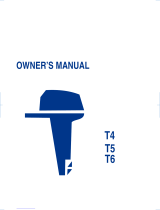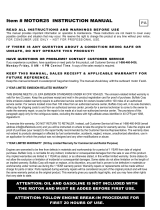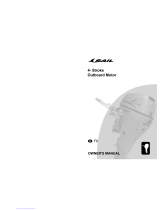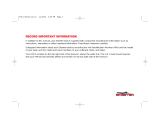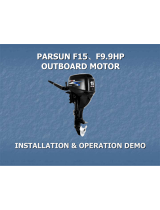
Table of contents
Safety information............................. 1
Outboard motor safety .................... 1
Propeller............................................ 1
Rotating parts.................................... 1
Hot parts ........................................... 1
Electric shock.................................... 1
Power trim and tilt ............................. 1
Engine shut-off cord (lanyard)........... 1
Gasoline............................................ 1
Gasoline exposure and spills ............ 2
Carbon monoxide.............................. 2
Modifications ..................................... 2
Boating safety ................................. 2
Alcohol and drugs ............................. 2
Personal flotation devices ................. 2
People in the water ........................... 2
Passengers ....................................... 2
Overloading....................................... 2
Avoid collisions ................................. 3
Weather ............................................ 3
Accident reporting ............................. 3
Boat education and training .............. 3
Passenger training ............................ 4
Boating safety publications ............... 4
Laws and regulations ........................ 4
Boating organizations...................... 4
Basic boating rules
(Rules of the road) ........................ 4
Steering and sailing rules and
sound signals.................................. 5
Rules when encountering vessels .... 5
Other special situations..................... 6
General information .......................... 9
Identification numbers record.......... 9
Outboard motor serial number .......... 9
Key number....................................... 9
Read manuals and labels.............. 10
Warning labels ................................ 10
Specifications and requirements... 14
Specifications ................................ 14
Installation requirements ............... 16
Boat horsepower rating................... 16
Mounting motor ............................... 16
Remote control requirements........ 16
Battery requirements..................... 16
Specifications of Battery..................16
Mounting battery .............................17
Multiple batteries ............................. 17
Without a rectifier or Rectifier
Regulator ......................................17
Propeller selection ........................ 17
Start-in-gear protection ................. 18
Engine oil requirements ................ 18
Fuel requirements......................... 18
Gasoline .......................................... 18
Ring Free Fuel Additive...................19
Muddy or acidic water................... 19
Anti-fouling paint ........................... 19
Motor disposal requirements......... 20
Emergency equipment.................. 20
Emission control information......... 20
North American models...................20
Star labels .......................................21
Components .................................... 23
Components diagram.................... 23
Fuel tank .........................................24
Fuel joint..........................................25
Fuel gauge ......................................25
Fuel tank cap...................................25
Air vent screw..................................25
Remote control box ......................... 25
Remote control lever ....................... 25
Neutral interlock trigger ................... 26
Neutral throttle lever........................26
Tiller handle.....................................26
Gear shift lever................................26
Throttle grip ..................................... 27
Throttle indicator .............................27
Throttle friction adjuster...................28
Engine shut-off cord (lanyard)
and clip.......................................... 28
Engine stop button ..........................29
Manual starter handle .....................29
Starter button ..................................30
Main switch .....................................30
Steering friction adjuster .................30
Power trim and tilt switch on
remote control or tiller handle .......31
Power trim and tilt switch on
bottom engine cowling .................. 31




















